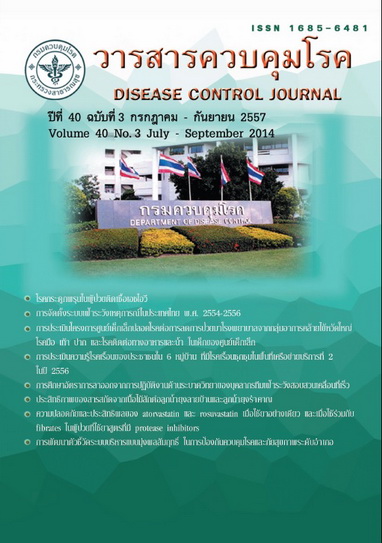Bioefficacy of Teak wood (Tectona grandis L.f.) extracts against Aedes aegypti (L.) and Culex quinquefasciatus Say larvae
DOI:
https://doi.org/10.14456/dcj.2014.14Keywords:
Teak wood, Tectona grandis L.f., extracts, Aedes aegypti (L.) larvae, Culex quinquefasciatus Say larvaeAbstract
The objective of this research was to investigate the efficacy of Teak wood (Tectona grandis L.f.) extracts obtained from both maceration and Soxhlet methods on mortality of the 3rd - 4th instars larvae of Aedes aegypti (L.) and Culex quinquefasciatus Say by using the dipping bioassay test. The mortality rates from different concentrations (0 (control), 0.25, 0.50, 1.00, 2.50 and 5.00% (v/v)) at 24 hours were trailed. The results showed the concentration of 5.00% obtained from maceration extraction was the highest toxic to Ae. aegypti (L.) larvae, causing 98.00% mortality and the mortality rates of the concentrations from 0.00-0.50% were not significantly different (p<0.05). More over, the soxhlet-extracted Teak at a concentration of 5.00% exhibited 100% mortality while the mortality rates of the concentrations from 0.00-0.50% were not significantly different (p<0.05). The mortality of Ae. aegypti larvae from both extraction methods was also not significantly different (p<0.05). For the mortality of Cx. quinquefasciatus Say larvae, the extract at 5.00% gained from maceration showed the highest mortality rates with 77.00% and the mortality rates of the concentrations from 0-0.50% were not significantly different (p<0.05). In addition, the Teak wood extract from soxhlet at a concentration of 5.00% displayed 100% mortality and the mortality rates of the concentrations from 0.00-0.50% were not significantly different (p<0.05). How¬ever, the mortality of Cx. quinquefasciatus larvae from both extraction techniques was statistically signifi¬cant (p<0.05). The Teak wood extract from soxhalation showed a high efficiency on average mortality than the extract from the maceration at 31.67 and 28.00%, respectively. Besides, the interaction between the extraction methods and concentration level was also shown. It was found that Soxhlet-extracted Teak wood at concentrations of 5.00% presented the highest mortality rate (100%). Therefore, the Teak wood extract in this study is likely to be further applied as larvicide for controlling the larval mosquitoes.
Downloads
References
2. กรมควบคุมโรค. สถานการณ์โรคไข้ชิคุนกุนยา (Chikungunya Fever) ประเทศไทย [อินเทอร์เน็ต]. [สืบค้นเมื่อ 30 มิ.ย. 2552]. แหล่งข้อมูล: http://203.157.15.4/ chikun/chikun/situation/y52/chikun_200906261457.pdf
3. สุภัทร สุจริต. กีฏวิทยาการแพทย์. กรุงเทพมหานคร: โรงพิมพ์บัณฑิตพัฒนา; 2531.
4. วิชัย คงงามสุข, ประคอง พันธุ์อุไร, อุษาวดี ถาวระ, สมภพ โคตรวงษ์. การพัฒนาการผลิตจุลินทรีย์สายพันธุ์ท้องถิ่น Bacillussphacricus H.5 เพื่อกำจัดลูกน้ำยุงรำคาญ. ใน; ดร.อุษาวดี ถาวระ, บรรณาธิการ. ผลงานวิจัยด้านกีฏวิทยาทางการแพทย์. กรุงเทพมหานคร: บริษัท ดีไซร์ จำกัด: 2546; หน้า 115- 26.
5. Braga, I.A., J.B.P. Lima, S.S. Soares, D. Valle. Aedes aegyptei resistance to temephos during 2001 in several municipalities in the states of Rio de Janeiro, Sergipe, and Alagoas, Brazil. Mem. Inst. Oswaldo Cruz 2004;99:199-203.
6. Saelim, V., Kankaew, P, Sithiprasasna, R. Temephos resistance by bottle and biochemical assays in Aedes aegypti in Thailand [Internet], [cited 2005 Sep 11]. Available from: http://esa.confex.com/esa/2004/tech-program/paper_14849.htm.
7. Wirth, M.C., Ceorghiou, C.P. Selection and characterization of temephos resistance in a population of Aedes aegypti from Tortola, British Virgin Islands. J. Am. Mosq Control Assoc 1999;15:315-20.
8. Cheng, S.-S., C.-G. Huang, W.-J. Che, Y.- H. Kuo, S.-T. Chang. Larvicidal activity of tectoquinone isolated from red heartwood-type Crytomeria japonica against two mosquito species. Bioresource Technology 2008;99:3617- 22.
9. Premrasmi T, H.H. Dietrichs. Nature and distribution of extractives in Teak (Tectonagrandis Linn.) from Thailand. The Natural History Bulletin of Siam Society 1967;22:1-14.
10. ทรรศนีย์ กิติรัตน์ตระการ, ยุพาพร สรนุวัฒน์. เทคโทควิโนนในไม้สักจากสวนป่า [อินเทอร์เน็ต]. [สืบค้นเมื่อ 26 ม.ค. 2555]. แหล่งข้อมูล: http://www.lib.ku.ac.th/ KUCONF/data52/ KC4701031.pdf
Downloads
Published
How to Cite
Issue
Section
License
Articles published in the Disease Control Journal are considered as academic work, research or analysis of the personal opinion of the authors, not the opinion of the Thailand Department of Disease Control or editorial team. The authors must be responsible for their articles.






